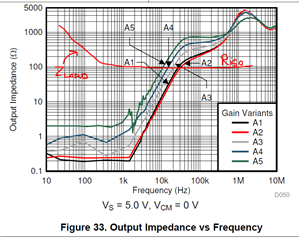Other Parts Discussed in Thread: INA186, INA190, INA213, INA296B, INA185, INA280, INA281, INA181
Hi
I have encountered an issue with INA186A2-Q1 I am using in one of the designs.
The schematic is attached bellow. I use a DCDC from 5V to 3.28V
The Max Current is 4.48A and typical is 2.56A.
I have placed a voltage divider on the output of the current sense amplifier to protect the ADC input from high voltage (max 0.6V)
DCDC switching frequency is 2.3MHz

The output of the DCDC measured on C329 @4.48A is relatively clean and has 7mV ripple with 20MHz BW of the Scope:
You can see the 2.3MHz on the spectrum view and additional 146KHz

On the other hand the output of the INA186 is very noise and has a ripple as high as 32mV measured on R272
I have measured the input on the INA186 with a differential (orange) probe and it can clearly be seen that there is no noise at 91KHz or110KHz but the output is strongly oscillating at this frequency


One of the test I made was adding a LPF (suggested in section 8.1.3 of the datasheet) on the INA input with series 100Ohm resistors and 47nF capacitor.
This reduce the output oscillation to 7mV but the 110Khz and 98KHz are still there but lowered by ~30dB

Additional finding on the INA186 output ringing.
The ringing frequency changes based on the supply Voltage
|
Supply Voltage |
Frequency |
|
1.75V |
30.5KHz |
|
1.8V |
9.3KHz and 18.5KHz |
|
1.85V |
8.5KHz and17.8KHz |
|
1.9V |
21KHz |
|
2V |
40KHz |
Attached oscilloscope print screens with spectrum view


